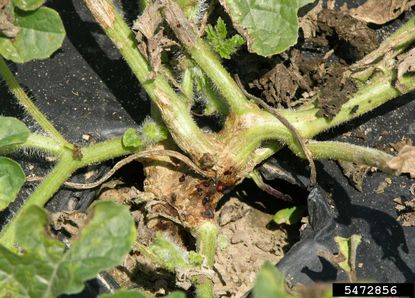Gummy Stem Blight Control - Treating Black Rot Fungus In Cucurbits


Gummy stem blight is a fungal disease of melons, cucumbers, and other cucurbits. It is a contagious disease that can spread across a field of fruits. The fungus damages the tissues of the stem at all stages of development. Stem blight treatment must start before you even plant the seeds to be entirely effective. Find out what is gummy stem blight so you can prevent this problem in your vegetable garden.
What is Gummy Stem Blight Disease?
Gummy stem blight fungus is most active during periods of warm, wet weather. The spores of the fungus can spread in soil or by air. The fungus will overwinter in milder climates in soil and plant debris. The leaves will get necrotic areas of dead tissue that turn brown and have a darker halo. The stems and fruit will show black, soft spots or large, brown lesions that are bordered by black. The dark coloring of these lesions also lends the disease the name of black rot fungus.
Black Rot Fungus Characteristics
Stem blight forms when seeds or sites are previously infected with fungal spores. When conditions are 85 percent humid or wet and warm, with temperatures averaging in the 60s, (16-21 C.), the fungal spores bloom. You should start treating black rot fungus at the first signs of the disease. Unfortunately, the first signs vary dependent upon plant species. Many get water spotting on the foliage or stems may ooze black or brown gummy beads of fluid. It is difficult to identify these early signs of gummy stem blight, which is why the preparation of the seedbed, purchasing resistant seeds, and rotating crops are important prequels to stem blight treatment. Ultimately, plants affected by this disease will bear rotten fruits, which are unmistakable and inedible.
Prevention of Gummy Stem Blight
The first stages of a disease-free cucurbit crop are preparation and rotation. Never plant cucumbers, melons, or other susceptible plants in the same area as the previous season's crop. The plant debris, and even seeds, left over in the soil will harbor the spores of black rot fungus. Careful preparation of soil prior to planting removes all old organic matter. Use seeds from a reputable seed company that has a history of fungus-free seeds. Since the disease can manifest even on seedlings, inspect any that you have purchased from a nursery prior to purchase and planting. Gummy stem blight signs on seedlings are brown lesions and dry leaf edges. Do not plant suspect specimens.
Treating Black Rot Fungus
In most cases, the removal of old plant debris, rotation, and resistant species will prevent the appearance of gummy stem blight. In climates with warm, moist bloom conditions, the fungal spores are carried on the wind, and you may have to combat the disease even if you took preventative steps. The most common method is the use of fungicides as a stem blight treatment. Dusts or sprays of fungicides useful for preventing and combating powdery or downy mildew have been shown to be effective against gummy stem blight disease.
Gardening tips, videos, info and more delivered right to your inbox!
Sign up for the Gardening Know How newsletter today and receive a free download of our most popular eBook "How to Grow Delicious Tomatoes."

Bonnie Grant is a professional landscaper with a Certification in Urban Gardening. She has been gardening and writing for 15 years. A former professional chef, she has a passion for edible landscaping.
-
 10 Best Apartment Plants To Turn Your Small Space Into An Oasis
10 Best Apartment Plants To Turn Your Small Space Into An OasisThe best apartment plants can lend an ambience of the tropics, brighten up a space, or add a touch of drama, and turn an apartment into a relaxing oasis.
By Amy Grant
-
 Grow a Bathroom Oasis: 8 Best Bathroom Plants With No Light or Low Light
Grow a Bathroom Oasis: 8 Best Bathroom Plants With No Light or Low LightSome apartment dwellers grow the best bathroom plants with no light or low light. Read how one of our favorite plant lovers does it in the big city.
By Teo Spengler